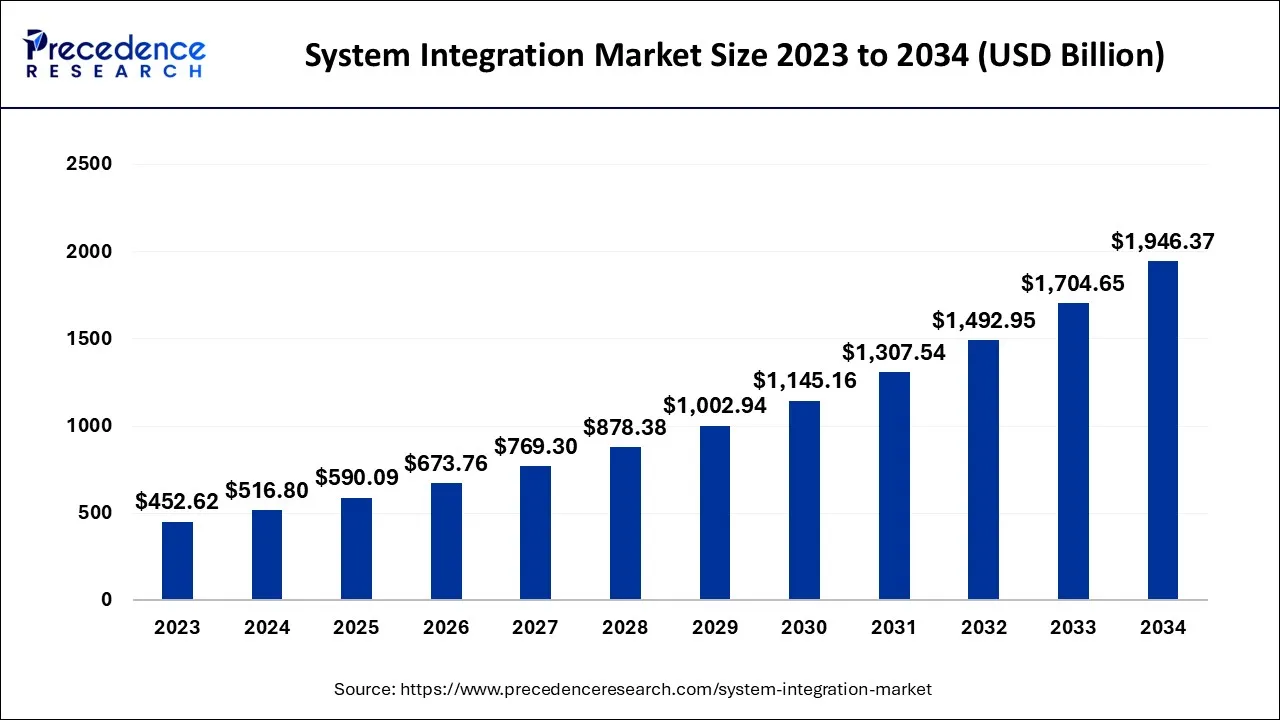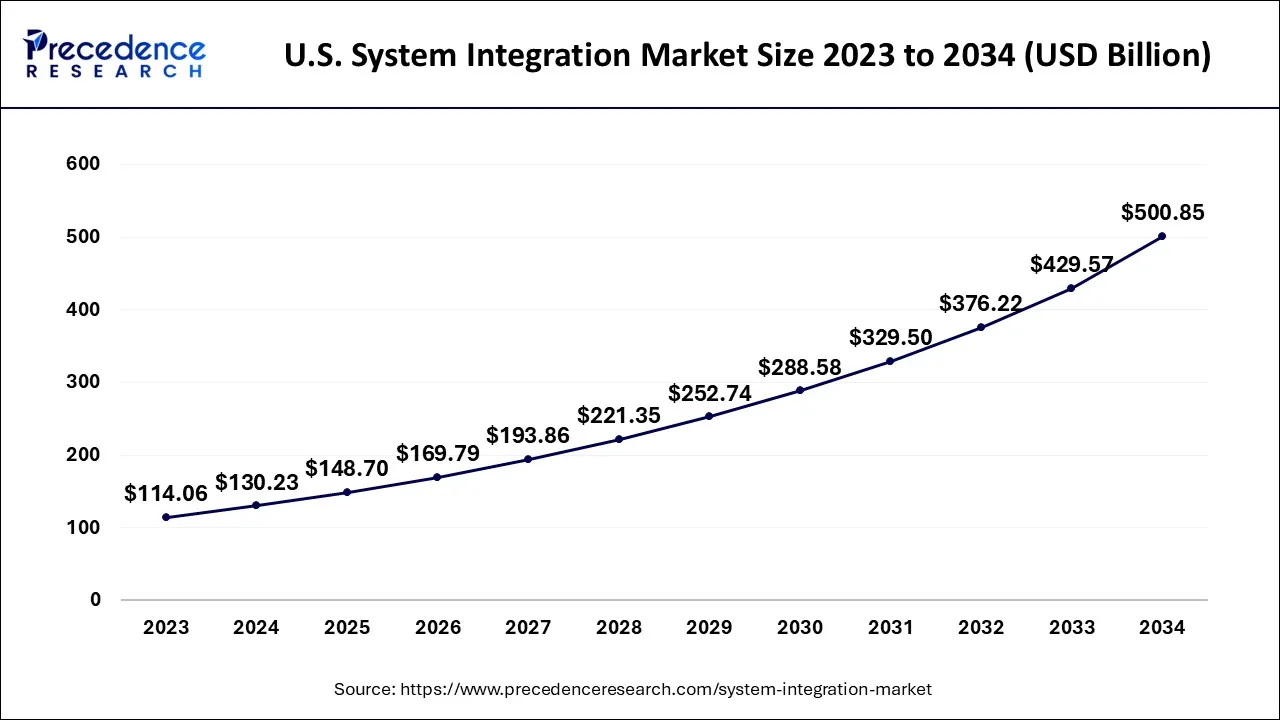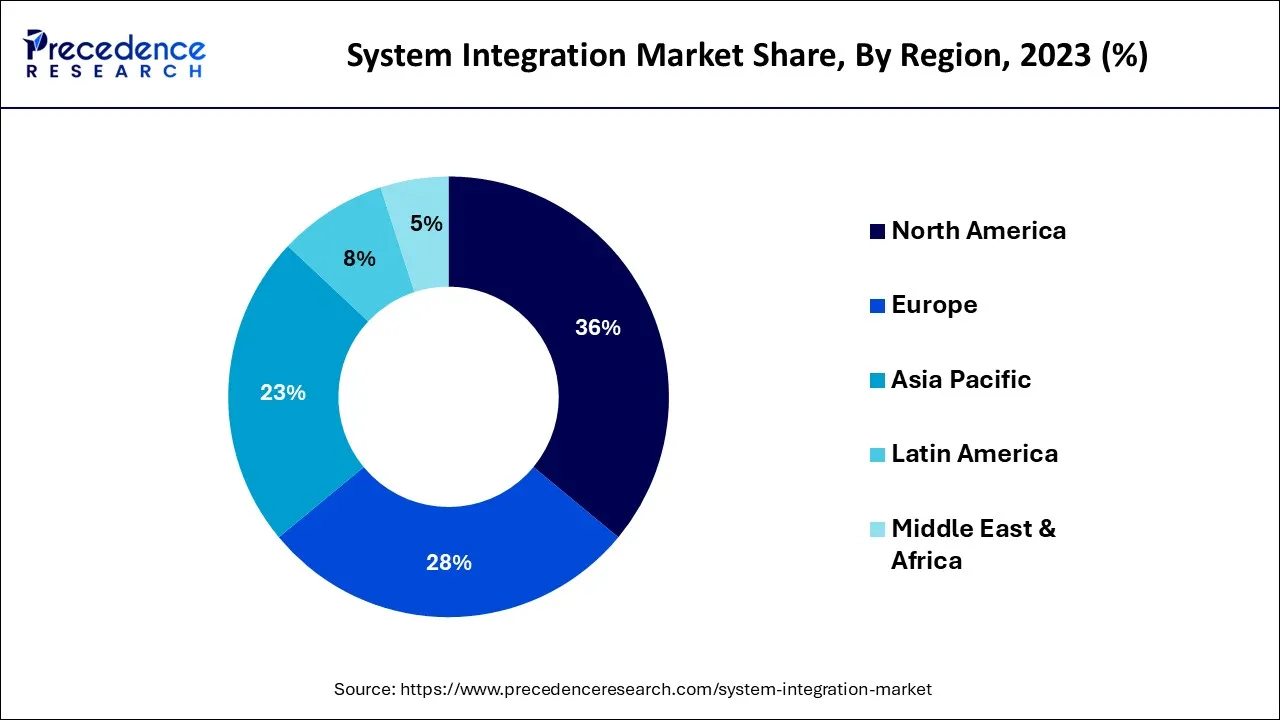System Integration Market Size and Forecast 2025 to 2034
The global system integration market size was estimated at USD 516.8 billion in 2024 and is predicted to increase from USD 590.09 billion in 2025 to approximately USD 1,946.37 billion by 2034, expanding at a CAGR of 14.18% from 2025 to 2034.

System Integration Market Key Takeaways
- In terms of revenue, the system integration market is valued at 590.09 billion in 2025.
- It is projected to reach 1,946.37 billion by 2034.
- The market is expected to grow at a CAGR of 14.18% from 2025 to 2034.
- North America dominated the market and generated more than 36% of the revenue share in 2024.
- By Services, the hardware integration segment contributed to the maximum market share in 2024.
- By End-use, the banking, financial services, and insurance (BSFI) segment recorded the largest market share in 2024.
U.S. System Integration Market Size and Growth 2024 to 2034
The U.S. system integration market size was exhibited at USD 130.23 billion in 2024 and is projected to be worth around USD 500.85 billion by 2034, growing at a CAGR of 14.42% from 2025 to 2034.

In 2024, North America dominated the system integration Market, accounting for the highest market share of about 36%.This is due to the rising adoption of cloud-based services among large organisations and the increasing use of IoT in industrial automation. Moreover, the region's BFSI sector has embraced modern technology, presenting significant growth opportunities for the North American system integration market. To that end, banks are taking great care to ensure every client's needs are met. Bank of America, for example, reports that 70% of its customers use digital services for their financial needs.

It can assist the bank in expanding its client base and remaining competitive in the market. North America has been highly competitive in the industrial automation market due to technological advancements, with the United States being a developed country that accepts advanced technologies for industrial operations. Automation solutions are becoming more common across industries as 5G wireless technology becomes more widely available. Furthermore, the industrial automation and IoT markets are expanding as demand foraugmented reality (AR) and virtual reality(VR) grows.
Market Overview
System integration refers to connecting sub-systems into a single, more extensive system that functions simultaneously. It links various IT systems, services, or software to enable them to work functionally collectively. Businesses use system integration to enhance the productivity and quality of their operations.
The systems integration industry manages the deployment-to-operation life cycle of complex IT solutions, offering a service that allows manufacturing processes and software to communicate in various markets, including oil and gas, automotive, aerospace and defense, healthcare, chemical and petrochemical, power generation, and others.
Market Scope
| Report Coverage | Details |
| Market Size in 2024 | USD 516.80 Billion |
| Market Size in 2024 | USD 590.09 Billion |
| Market Size by 2034 | USD 1,946.37 Billion |
| Growth Rate from 2025 to 2034 | CAGR of 14.18% |
| Largest Market | North America |
| Base Year | 2024 |
| Forecast Period | 2025 to 2034 |
| Segments Covered | Services, End-Use, and Region |
| Regions Covered | North America, Europe, Asia-Pacific, Latin America, and the Middle East & Africa |
Market Dynamics
Driver
System integration has become highly complicated as more industrial manufacturing companies automate their operations. Industrial manufacturers are integrating more automation and robotics into production lines to increase output, reduce labour, and control energy usage and plant maintenance costs. Businesses are looking for ways to improve communication throughout their manufacturing systems and handle numerous attributes of their diverse processes.
In many cases, these manufacturers combine predictive maintenance sensors and systems with software, machines, and data tools from various suppliers to ensure less downtime. This adds to the complexity as users work to integrate disparate data system technology designed to be separate data processing systems that do not usually exchange data or interact with other computer data processing systems. Thus, the rise in the adoption of industrial automation technologies is driving the market growth.
Restraint
The instrument's dependability and accuracy are significant considerations in its adoption. As a result, manufacturers must continue to invest in R&D to provide the best solutions. A control valve is a crucial component of the process in the process industry. The size of the plant and the level of automation required determines the requirement and cost of the valve.
The process's automation also raises the overhead costs and the control valve costs between a thousand and more than a hundred thousand dollars. Although automation provides long-term benefits, the high initial investment prevents businesses from implementing full automation. This limits the market for process industry system integrators.
Opportunity
Many industrial companies are implementing digitaltransformationinitiatives to improve business processes and outcomes. However, the operation technology (OT) groups in charge of industrial systems require assistance in deploying IT systems. Such OTI/IT convergence is expected to open new opportunities for IT solution providers and industrial system integrators.
IT solution providers and industrial system integrators can assist businesses in bridging the OT/IT divide while also providing expertise in designing, deploying, and managing IT infrastructure that enables digitalization.
Moreover, consumer preference for virtualization is expected to drive the market. Virtualization validates the simultaneous execution of many applications and allows users to simultaneously perform multiple tasks on the same server. It improves computer hardware efficiency, utilization, and flexibility while lowering additional IT operating costs. Furthermore, market players' increasing demand for flexible manufacturing providers expands the advantageous opportunities for the growth of the system integration market in the coming period.
Services Insights
Based on services, the system integration market is segmented into infrastructure integration, application integration, and consulting. In 2023, the hardware integration segment accounted for the largest market share. The growth of this segment is driven by technological advancement with rising innovations in hardware devices with wireless technologies. Hardware integration refers to the process of connecting hardware and software. Companies use hardware integration services in the modern era to transform traditionally office-based computing functions into mobile functions.
As the accessibility and reliability of wireless internet connections have improved over the last few years, so has the use of apps. Industries such as technology and other gig-based businesses have transitioned to mobile applications. Businesses use app integrations to handle inventory management, video surveillance, cloud computing networks, payroll functions, and other functions.
End-Use Insights
Based on end-use, the system integration market is segmented into IT & telecom, defense & security, BFSI, oil & gas, healthcare, transportation, retail, food & beverages, automotive, and others. In 2023, the banking, financial services, and insurance (BSFI) segment accounted for the highest market share.
To address the banking sector's crucial requirements, system integration enables safe, smooth, and quick banking operations by constructing an IT infrastructure. Various companies in the BFSI sector collaborate with system integrators to widen their banking services and enrich their brand representation, thereby driving system integration demand in the BFSI sector.
Moreover, rising fintech start-ups, significant demand for banking-as-a-service (BaaS), the proliferation of neo-services and shifting several governments' focus toward the digital economy are the vital factors fueling the growth of this segment. Furthermore, due to the negative impact on offline banking services, the COVID-19 pandemic has accelerated the adoption of digital payment systems, contributing to market growth.
System Integration Market Companies
- Capgemini
- Accenture
- IBM
- Infosys Limited
- Tata Consultancy Services
- John Wood Group
- Cognizant
- Wipro
- Johnson Controls
- JR Automation
Recent Developments
- In Jan 2022,North America's prominent manufacturer of self-driving mobile robots, Mobile Industrial Robots (MiR), has recently certified Proud Automation, a subsidiary of the RG Group, as one of its approved systems integrators. The certification adds to the recognition of Proud Automation's expertise in integrating MiR's autonomous mobile robots into industrial manufacturing processes. The growing adoption of MiR's AMRs is driving the demand for system integrators like Proud Automation to assist companies in implementing these robots and meeting their customers' requirements efficiently.
- In 2022,The Canadian province of Newfoundland and Labrador has recently awarded funding to Wood, an energy services company, to aid the region's offshore oil and gas sector in its recovery efforts while creating job opportunities. Wood's project will focus on maintenance and establishing a regional network for autonomous robotic inspection and testing.
Segments Covered in the Report
By Services
- Infrastructure Integration
- Application Integration
- Consulting
By End-Use
- IT & Telecom
- Defense & Security
- BFSI
- Oil & Gas
- Healthcare
- Transportation
- Retail
- Food and & Beverages
- Automotive
- Others
By Geography
- North America
- Europe
- Asia-Pacific
- Latin America
- The Middle East and Africa
For inquiries regarding discounts, bulk purchases, or customization requests, please contact us at sales@precedenceresearch.com
Frequently Asked Questions
Ask For Sample
No cookie-cutter, only authentic analysis – take the 1st step to become a Precedence Research client
 sales@precedenceresearch.com
sales@precedenceresearch.com
 +1 804-441-9344
+1 804-441-9344